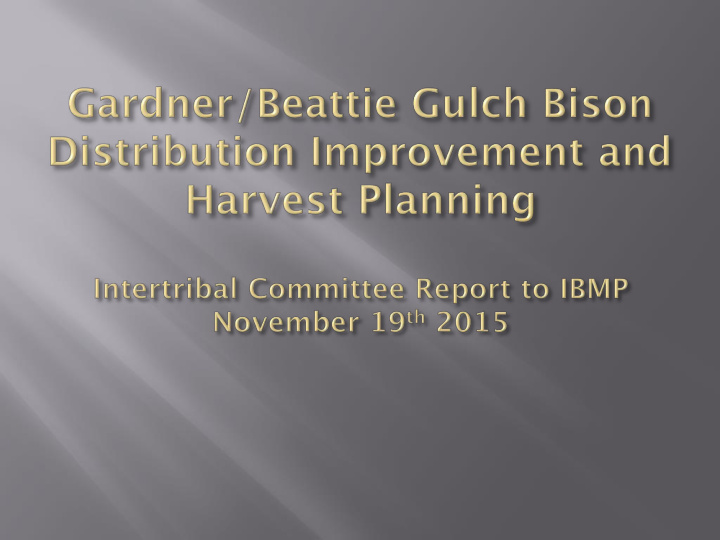



The Challenges: Small Dissected hunt areas • • Long history of hazing and limited herd memory for use of habitats outside the park • Unpredictable weather and movement of bison Hunting areas close to housing and in the public view • Hunting activities near park boundary limiting bison movement • out of the park and can cause health and human safety issues • Multiple hunt parties pursuing limited number of animals • Risk of U.S. Forest Service continuing to take unilateral action to restrict hunt area due to real or perceived health and human safety issues associated with hunting near homes and attraction of grizzly bear
Expand harvest opportunities for tribal treaty 1. hunters throughout the hunting season by increasing the number of bison available and expanding their distribution on open and unclaimed lands outside of YNP Improve bison use of habitats available outside 2. YNP including lands in open and unclaimed status where treaty harvest is permissible Establish bison “herd memory” of the extensive 3. and prolonged use of public lands outside YNP
Improve hunter safety and the quality of the hunt 4. by expanding bison distribution into all available hunt areas and better distributing hunters Reduce health and safety concerns created by 5. concentrating harvest at Beattie Gulch Reduce the likelihood that the USFS may place 6. further restrictions on bison hunting in portions of the Beattie Gulch area or elsewhere where health and human safety issues may arise
Develop mutually acceptable regulations that provide for regular predictable periods for bison to migrate out of the park on the west side of the Yellowstone River while minimizing restrictions on treaty and sport harvest Any regulation should: • have a high probability of achieving the objective of improved bison distribution and improved availability to hunters • maintain some opportunities for hunting open at all times within the Gardner Basin and West Yellowstone hunt areas be simple and clear to limit any enforcement issues and eliminate the • possibility of misunderstandings by hunters be predictable to permit hunters surety and confidence in planning their • hunts would be reevaluated annually for effectiveness and level of realized • benefit to the involved tribes and adjusted accordingly
Address barriers to natural migration on west side of • Yellowstone River caused by hunting through implementation and monitoring of special hunt regulations Stop use of trap during hunting season • Expand hunting as primary tool to manage population • through increased success tribal and state harvest Pursue better access to retrieve game from FS lands and • Park
Address habitat quality both within and outside the Park • through partnerships between Tribal co-managers, w/ NGO’s, Feds, and States Encourage movement of bison within the park to facilitate • distribution outside the park. (habitat enhancement and hazing into under or un-utilized habitats and migration corridors) Get rid of trap in YNP and move trap to a more appropriate • location at the limit of bison migration/tolerance zone on FS lands Address barriers to natural migration on west side of • Yellowstone River caused by human development and ownership patterns w/ focus on the narrow corridor on the west side of the Yellowstone River
Curtail all hunting activity in the Gardner Basin on the west side of the Yellowstone River every other week (Monday – Thursday) beginning the second full week in September and continuing through March 31 st with exceptions for holidays Conditions: YNP must agree to keep trap closed until March 31 st 1. Forest Service and YNP work with Tribes on access to retrieve game 2. Forest Service and YNP work with Tribes to develop landscape analysis 3. and habitat restoration recovery efforts
Recommend
More recommend